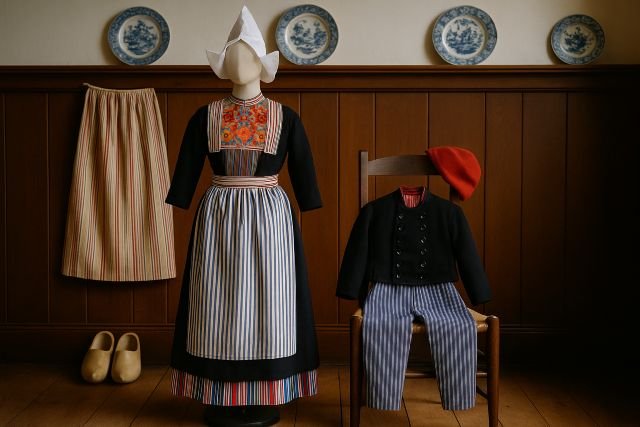The traditional costume Netherlands is more than a quaint image of wooden shoes and lace caps — it’s a vibrant tapestry of Dutch history, culture, and regional identity. These distinctive garments, once everyday wear in rural communities, now serve as cultural symbols of pride, artistry, and heritage.
From the iconic Volendam dress to the intricate embroidery of Marken and Friesland, each region’s costume tells a unique story about the Netherlands’ past and its people’s way of life.
The Historical Roots of Dutch Traditional Costume
Traditional Dutch costumes trace their origins back to the 16th and 17th centuries, when local communities developed distinctive dress styles influenced by trade, climate, and religion. During the Dutch Golden Age, regional costumes evolved into a reflection of social status and profession.
By the 19th century, the Netherlands had over 100 identifiable regional styles, each shaped by geography and local traditions. These garments often included:
- Wool skirts and bodices in colder coastal regions.
- Light linen fabrics for inland farming communities.
- Headdresses and caps indicating marital status or age.
For example, in Marken, unmarried women wore white caps, while married women wore dark blue ones — a subtle yet important social signal.
Symbolism and Meaning Behind Traditional Costume Netherlands
Beyond aesthetics, the traditional costume Netherlands carried deep cultural meaning.
- Colors and patterns reflected regional pride.
- Embroidery motifs symbolized faith and prosperity.
- Headdresses often served as status markers.
In fishing villages such as Volendam, sailors’ wives wore bright, durable fabrics to express hope for safe voyages. Meanwhile, the Zuid-Beveland region’s costumes featured gold filigree jewelry — a display of local craftsmanship and wealth.
Regional Variations of Dutch Traditional Dress
Dutch traditional attire is remarkably diverse. Below are some of the most famous regional costumes that continue to fascinate historians and travelers alike:
| Region | Key Features | Notable Elements |
|---|---|---|
| Volendam | Iconic striped blouse, dark skirt, and lace cap | Often featured in postcards symbolizing Dutch identity |
| Marken | Vibrant embroidered bodices and aprons | Distinct red underskirt and blue outer layers |
| Friesland | Elegant black dresses and golden headpieces | Signifies pride and independence |
| Zuid-Beveland | Gold and silver jewelry adornments | Highly detailed lace collars |
| Staphorst | Hand-painted dotted patterns on fabric | Preserves 19th-century Protestant modesty |
| Spakenburg | Richly decorated aprons with lace sleeves | Colorful shawls for special occasions |
These regional styles developed largely due to isolation — with waterways, dialects, and trade routes influencing each community’s distinct aesthetic.
The Role of Religion and Social Status
Religion played a significant role in the evolution of Dutch costumes. In Protestant regions like Staphorst, modesty and simplicity were valued — leading to subdued color palettes and covered silhouettes. Catholic areas, on the other hand, favored more elaborate designs and accessories.
Social hierarchy was also reflected in attire. Wealthier families could afford imported fabrics such as silk or velvet, while farmers and fishermen relied on durable wool and linen.
Traditional Costume Netherlands in Modern Culture
Today, traditional Dutch costumes are worn mainly during:
- Festivals and folklore events (e.g., King’s Day, Tulip Festival)
- Tourism and cultural exhibitions
- Heritage preservation projects and museums
Institutions like the Zuiderzee Museum and the Dutch Costume Museum in Amsterdam continue to showcase these garments, keeping the legacy alive.
Modern Dutch designers occasionally draw inspiration from these regional styles, blending historic motifs with contemporary fashion trends.
Frequently Asked Questions
1. Do Dutch people still wear traditional costumes?
Only a few communities, such as Staphorst, maintain traditional dress for daily or ceremonial use. Most people wear them during festivals or tourism events.
2. What is the most famous Dutch traditional outfit?
The Volendam costume — with its striped blouse, dark skirt, and lace cap — is the most globally recognized symbol of Dutch folk attire.
3. Why are wooden shoes (clogs) associated with Dutch costumes?
Known as klompen, wooden shoes were practical for farming and fishing due to their durability and waterproof nature. They often accompanied traditional regional costumes.
Preserving the Heritage of Dutch Folk Dress
Efforts to preserve the traditional costume Netherlands reflect a broader cultural commitment to heritage. Organizations and historians document regional patterns, photograph aging garments, and recreate costumes using authentic techniques.
You can even find workshops across the Netherlands where artisans teach embroidery, lace-making, and headdress construction to new generations.
Conclusion
The traditional costume Netherlands remains a timeless reflection of Dutch identity — weaving together artistry, history, and local pride. Each region’s dress serves as a living testament to the nation’s craftsmanship and community spirit.
As modern Dutch culture embraces innovation, these traditional garments continue to inspire — connecting the Netherlands’ rich past to its creative present.
